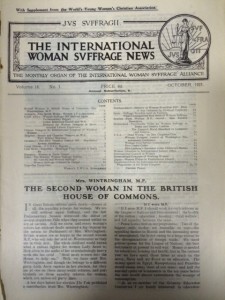With David Cameron’s recent cabinet reshuffle weighing on my mind, I decided to take a browse through the GWL Archives to discover more about our first female figures in parliament. There is no doubt these were inspiring women; the words ‘courageous’, ‘out-spoken’ and ‘quick-witted’ seem to follow them in the archives Suffragette literature.
The first female MP to be elected to Parliament and to take her seat was Viscountess Nancy Astor, originally of Virginia in America. After a failed marriage, Lady Astor was able to divorce her husband and gain custody of their son Robert. She moved to England in 1903, married Viscount William Waldorf Astor in 1906 and together they had 5 children.
 In 1919 Lady Astor campaigned to stand in her husbands stead and take his seat as Member of Parliament for Plymouth. She won the election and became a fighting force in the House of Commons, devoted to the causes of women and children, education and nursery schools.
In 1919 Lady Astor campaigned to stand in her husbands stead and take his seat as Member of Parliament for Plymouth. She won the election and became a fighting force in the House of Commons, devoted to the causes of women and children, education and nursery schools.
“I intend to work for the Peace, Progress and Prosperity of the Country. I shall, at the same time, have due regard to National Efficiency and Economy which women above all understand.”
Lady Astor’s Campaign Leaflet 1919
“I know what I am talking about, and you must remember that women have got a vote now and we mean to use it, and use it wisely, not for the benefit of any section of society, but for the benefit of the whole. I want to see what the Government is going to do…”
Lady Astor’s maiden speech to the House of Commons on 24th of February 1920.
However, the Viscountess was not popular with all. It was reported that Winston Churchill and Lady Astor were in a constant tiff, with their public disagreements a source of entertainment for many accidental witnesses.
“When Winston attempted to both tease and ridicule her by stating that having a woman in Parliament is like having one intrude on him in the bathroom, she serenely replied: “You’re not handsome enough to have such fears”, provoking general dissimulated laughter amongst the stiff diplomats.”
“Also, at his impolite question about what disguise he should wear so that nobody could recognize him at the Astor’s “stupid” masquerade ball, Nancy ironically responded using rhetoric: “Why don’t you come sober, Prime Minister?””
Viscountess Astor was certainly a woman of character and intelligence, with a sharp tongue and a sharper wit.
Fast forward 94 years, how do we see the role of women in Parliament today? Last week’s Cabinet reshuffle takes the total of women in the Cabinet to five; a stepping stone in the right direction in terms of encouraging women into politics, yet statistically we females are still a minority. The media blasted Cameron’s promotion of 10 female ministers as a “token gesture”, nicknaming it the “Night of the Long Wives” or worse, using the entrance of the new female appointments to construct a “Downing Street Catwalk”.
It seems clear to me that, although huge developments have been made in the 100 years since Viscountess Astor first stepped into the House of Commons, women are still fighting to be heard, represented and valued on equal terms.
If you are interested in browsing the Suffragette magazines or anything else in our archives, please don’t hesitate to contact us at info@womenslibrary.org.uk

Comments are closed.